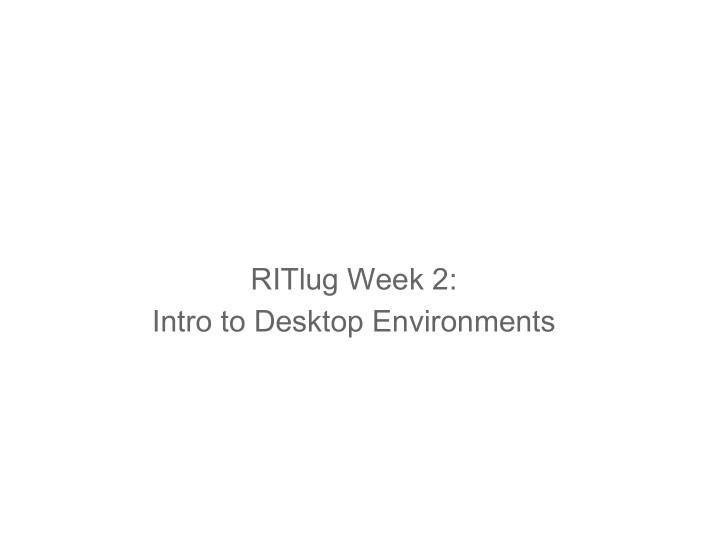



RITlug Week 2: Intro to Desktop Environments
What exactly is Linux anyway? Generally when someone refers to Linux - they are really referring to a specific Linux distribution Linux itself is only an operating system kernel. A bridge between all the applications that you use and the hardware of the computer itself. Most people do not need to interact directly with the Linux kernel itself. That is there the Desktop Environment comes it.
Okay, so what is a Linux distribution then? A Linux distribution (or distro) is the operating system that you interact with. It includes a specific Desktop Environment that provides a "look and feel" for that system as well as all the programs that you would use on a day to day basis. Some of the most popular distros are Arch, Debian, Ubuntu, Fedora, Gentoo, and openSUSE.
Various Desktop Environments The huge number of desktop environments and distros is what makes Linux the most exciting. You can customise your system to work the way that you want, look the way that you want, and tailor it specifically to YOU. There are currently around 300 active Linux distros, so there is plenty of customization going on already!
Desktop Environments A look at customizing your Linux system!
First, a look at two desktop environments that most people know quite well...
Windows 7 – Aero Desktop The Windows 7 Desktop Environment is called Aero. It features the glasslike window edges and uses a taskbar to show the currently running programs. The user can pin applications to the taskbar for easy access.
Mac OS X– Aqua Desktop The Mac OS X Desktop Environment is called Aqua. Features a water-like theme. Uses a “Dock” for applications as well as the top toolbar for global menu access.
What can Linux look like then? Following are a few of the most common Linux Desktop Environments.
XFCE Desktop Environment XFCE is a lightweight (low memory usage, fast) desktop environment. It is available on many different linux distributions. It features a “panel” similar to the Windows taskbar that shows the current running program.
LXDE Desktop Environment LXDE is described as “an extremely fast-performing and energy-saving desktop environment.” It is also avalible on various linux distributions including Debian, Fedora, OpenSUSE and Ubuntu.
GNOME Shell Desktop Environment Gnome Shell (Gnome3) is used by default in the Fedora linux distribution. It not only features a beautiful application switcher and interface, but comes with the full Gnome suite of applications. It is available on Debian, Ubuntu, Linux Mint, openSUSE, and openBSD as well as others.
Cinnamon Desktop Environment Cinnamon is a version of the Gnome Shell that was created by the Linux Mint team (another Linux Distro). It attempts provide a more traditional desktop interface. It supports custom extensions and applets that allows the user to install extra functions for the desktop for further customization!
Unity Desktop Environment Unity is used primarily by the Ubuntu linux distribution. It features a launcher to control and launch applications and an overlay for quick searching of other files and applications.
KDE Desktop Environment KDE is not only a desktop interface but, like Gnome, an entire suite of applications. KDE is made to run on Linux, FreeBSD, Windows, Solaris and Mac OS X systems.
Slightly more technical... What makes this better than using Windows 7 or Mac OS X then?
Package Managers One of the things that is most useful about Linux distributions is the existence of package managers. Most Linux distributions have a software repository. A huge list of programs that are available for that distro, similar to an app store. Most (almost all) of the software in these repositories is completely free for you to download and use.
Speed Linux systems tend to be faster, and run better on older computers, than recent versions of Windows or Mac OS. This is extremely apparent if you use a more "lightweight" desktop environment! My laptop here is 5 years old now, and it runs Ubuntu (with all desktop effects enabled) like a champ!
Hardware Compatibility In the past compatibility with computer hardware was a shortfall of Linux. In recent years, however, it has become one of the strong points! Advances in Linux kernel and better driver support now allows linux to work with just about any hardware that you throw at it, new or old.
Recommend
More recommend